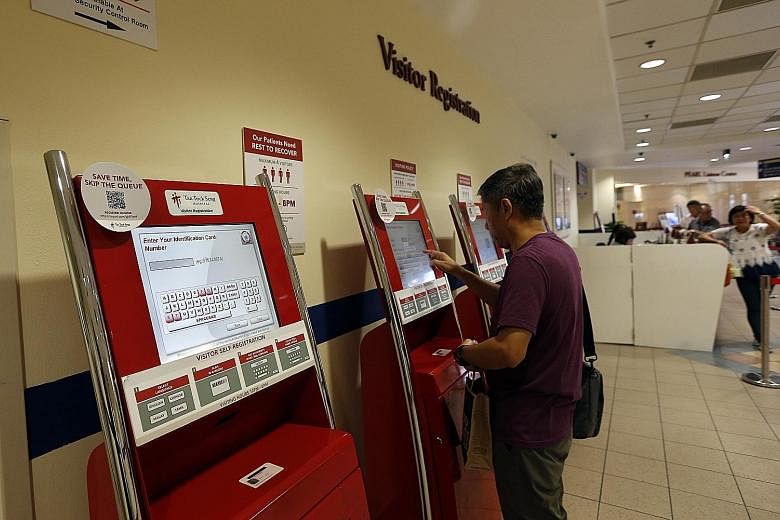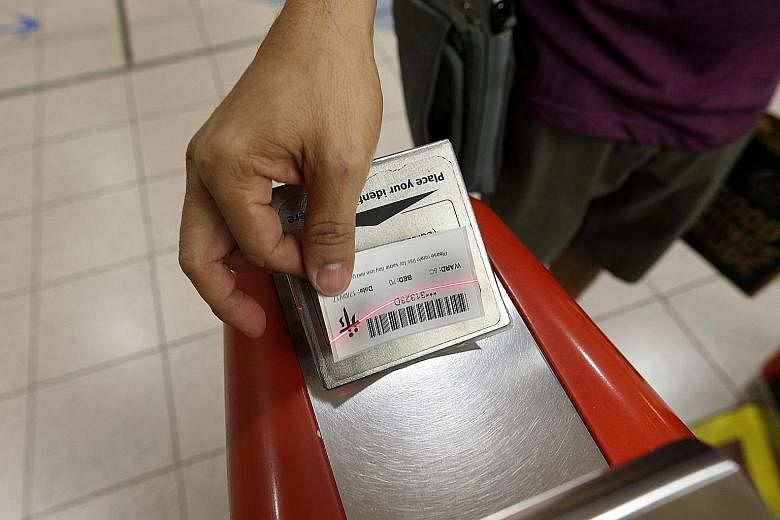By early next year, all six acute general hospitals here will have a system in place to keep track of visitors going in and out of wards, to ensure the safety and security of patients.
Khoo Teck Puat Hospital (KTPH) and National University Hospital (NUH) will join the ranks of Changi General Hospital, Singapore General Hospital (SGH), Ng Teng Fong General Hospital and Tan Tock Seng Hospital (TTSH) in having such a visitor management system, which will come complete with gantries.
The system requires visitors to register visits using their identity cards at a counter or through automated booths. Foreign visitors without ICs can log their names at the registration counter.
The change, which was first reported by the Today newspaper, comes after a Ministry of Health (MOH) advisory to public hospitals that was given "in the light of the heightened security risks in Singapore and around the world", said a KTPH spokesman.
MOH, responding to queries from The Straits Times, would say only that it regularly reviews security measures in public healthcare institutions.
The issue of hospital security was also raised in Parliament last year when MPs were keen to know what security measures are in place for key installations.
In its advisory, MOH said public healthcare institutions must remain vigilant and alert.
Some public hospitals said they already have several security measures in place, even before the visitor management system.
For instance, visitors to KK Women's and Children's Hospital have to register before accessing other levels of the hospital after visiting hours.
Some public hospitals also use closed-circuit television systems, conduct joint patrols with the police, and constantly remind their staff to be vigilant.
There are other potential benefits of the visitor management system, said hospitals.
It allows them to provide patients with a more conducive environment for recovery, said NUH.
SGH, which installed automated gantries in 2012, said it did so to better manage visitors of patients with complex medical conditions and weaker immunity, said Mr Peter Tay, deputy director for operations support at SGH. "This will allow our patients to get the adequate rest needed to recover and reduce any potential exposure to infection from external sources," he said.
In most public hospitals, each patient in the general wards is allowed up to four registered visitors during visiting hours.
While the visitor management system is set to be commonplace in many public hospitals, some specialist, community and private hospitals are unlikely to follow suit.
The Institute of Mental Health, a public psychiatric hospital, and Bright Vision Hospital, a community hospital, do not have a visitor management system.
Mount Alvernia Hospital, a private hospital, also does not have this system, but will be studying and exploring its feasibility.
The four private hospitals under Parkway Pantai - Gleneagles Hospital, Mount Elizabeth Hospital, Mount Elizabeth Novena Hospital and Parkway East Hospital - do not have visitor management systems.
Mr Phua Tien Beng, Parkway Pantai's acting chief executive of the Singapore operations division, said its hospitals have smaller and more personalised wards, and a lower volume of visitors compared with public hospitals.
Thus, hospital staff are able to monitor and control visitor access to the wards without the system.
Ms Cecilia Foo, 28, who was at TTSH visiting a patient, said registering visitors and controlling access using gantries are good moves.
"The hospital (TTSH) has done a very good job with visitor registration. Now they are able to track visitors if anything happens," she said.
Correction note: This story has been edited to clarify that visitors to KK Women's and Children's Hospital will have to register with their ICs after visiting hours.


